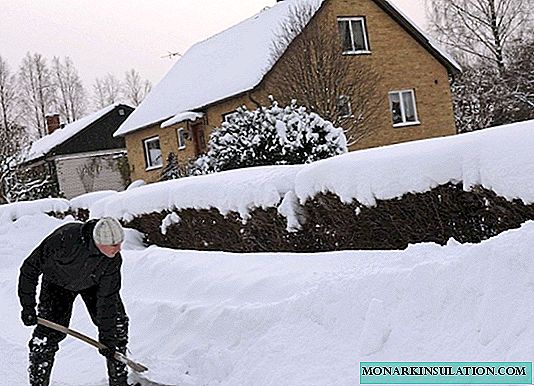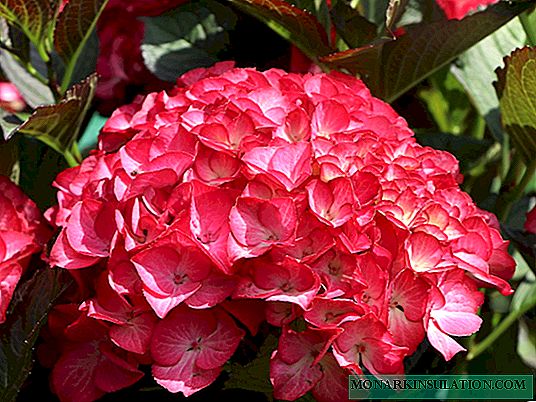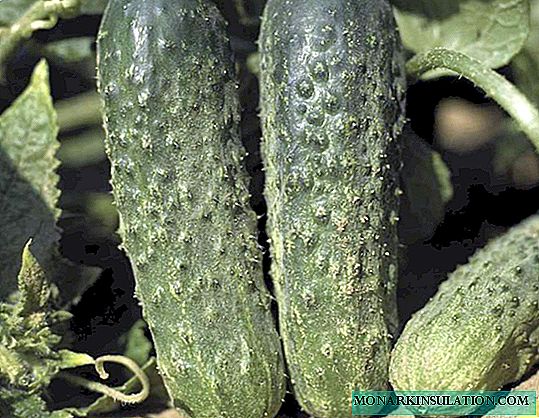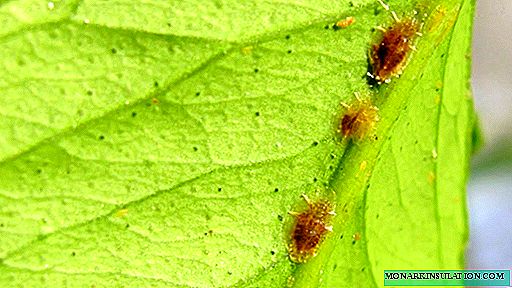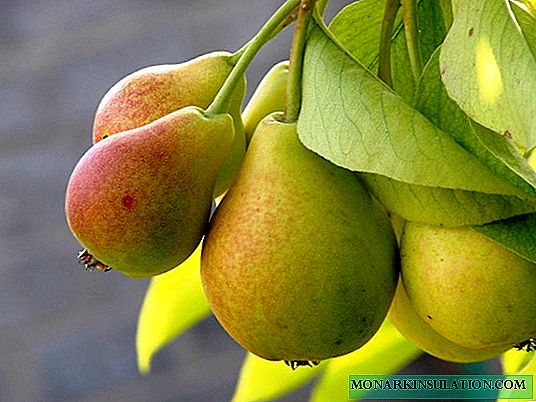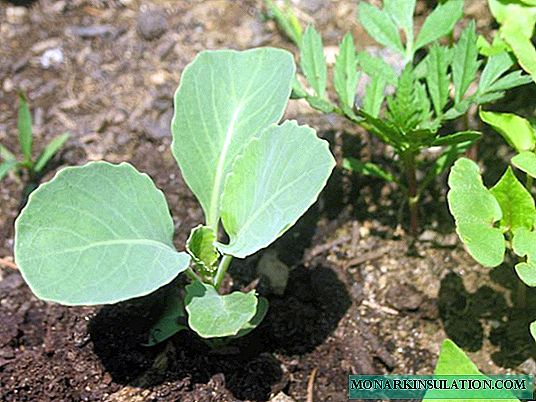
Many gardeners like to cultivate cabbage, but not everyone succeeds. For various reasons, there is no way to grow seedlings at home or in a greenhouse. In this case, you can perform direct sowing of seeds into the ground, which is suitable for many types of this crop (white-headed, kohlrabi, Peking, broccoli).
Preparing a site for planting cabbage
Before embarking on a planting of such a crop as cabbage, you must correctly select and prepare the site. Future beds should be placed in an open and unshaded place. To prevent the development of diseases and pests, it is necessary to comply with crop rotation rules, alternating planting crops. Cabbage should be planted at the same place no earlier than 4 years later. The best predecessors for it are potatoes, onions, legumes, cucumbers.
Cabbage loves loose and fertile soil with enough moisture. To achieve a good structure, organic fertilizers are applied to the soil, such as manure or compost at the rate of 5-7 kg per 1 m². It is best to fertilize the soil in the autumn for digging.

In the preparation of the cabbage beds, in the fall, manure is made under digging in the autumn
Until spring, nutrients will turn into a digestible form for plants. Depending on the type of soil, mineral fertilizers are additionally used:
- on peat soils, which are characterized by a lack of potassium, it will require the introduction of 20-40 g of potassium chloride per 1 m²;
- on sandy soils that are poor in potassium and phosphorus, superphosphate 40-60 g and potassium chloride 20-50 g per 1 m² are added;
- acidic loams must be deoxidized by applying lime or ash 80-100 g per 1 m².

In addition to organic matter, mineral fertilizers are added to the soil, and loams are deoxidized by the application of ash
For cabbage, soils with an acidity close to neutral (pH 6.5-7) are most preferred. On acidic soils, the culture undergoes the development of a disease such as keel.
In the autumn period, the area under the cabbage is dug to a depth of 20-25 cm and left not loosened until spring. With the advent of heat, the ground is leveled with a rake. Before sowing, the beds are dug to a depth of about 7 cm, followed by leveling. If the land has not been prepared since the fall, then in early spring, the site is dug up to the depth of the bayonet of a shovel and scanned with a rake.
How to choose cabbage seeds for planting
The selection of seed material needs to be given special attention, because the volume and quality of the future crop directly depend on it. Let us consider in more detail what criteria should be considered when selecting seeds:
- Cultivation region. There are many varieties of cabbage that are bred for specific regions, which is always indicated on the packaging with seeds. If such information is not available, then a plate is given that can be used to determine when sowing and harvesting is carried out. The longer the cabbage growing period, the more warm the region is needed for cultivating it.
- Soil characteristics. Depending on the selected variety, the type of soil on which the crop gives the best yield should be taken into account.
- Ripening dates. Cabbage is divided into several ripening groups: early (ripen within 50-120 days), medium (90-170 days) and late (160-270 days). When choosing seeds, you need to take this indicator into account, and not plant a crop of the same type.
- What is cabbage grown for? The choice of variety also depends on what the vegetable will be used for: for salads, pickles or for storage fresh. Such information should be given on the label or packaging.
- Resistance to diseases and pests. Each grade has its own characteristics. So, there are varieties that are endowed with resistance to diseases and pests, but they cannot boast of high productivity, and there are fruitful varieties, but with less resistance. This indicator must be taken into account, since it will be necessary to provide appropriate care.
- Resistance to cracking. It is better to give preference to varieties that are not prone to cracking, because not only the appearance of the heads worsens due to this nuance, but also storage problems arise: cracked heads are not stored for a long time.
- Local varieties. To grow cabbage on your site, it is better to purchase zoned varieties, i.e., local breeding. After all, it is precisely such seed material that will best suit your climatic conditions.
Video: how to choose cabbage seeds
How to get seeds yourself
Gardeners think about getting their own seeds of cabbage if they liked a certain variety, but there is no certainty that next season there will be an opportunity to purchase it. It is within the power of everyone to produce seed material. The main thing is not to use hybrid varieties for these purposes, since varietal traits are not preserved in them.
First you need to understand that to obtain seeds, cabbage is classified as follows:
- mother liquor is a plant of the first year of cultivation that is familiar to everyone and forms a head of cabbage;
- seed plants - mother liquors planted in the second year, from which flowers and seeds are formed.

As a mother liquor, plants with a large head of cabbage, a small stump and a small number of leaves near the head are chosen
For uterine plants, only high-quality planting material of the variety that you want to propagate is selected. Medium-late and late varieties are best suited for these purposes. This is due to the fact that they are better preserved until landing in the next season. Cabbage, which will be used as a uterine plant, should have the largest head of cabbage, and the cob and green leaves should be as small as possible. Low plants with a thin stalk and a small amount of external leaves at the head should be selected for mother plants.

From the cabbage stalk, flower stalks will develop next year, from which seeds are subsequently collected
Plants of the first year are removed before the onset of frost. If they are slightly frozen, then you need to give them some time to "move away". For the purposes in question, it is better to sow cabbage directly into the ground. Such plants have a more powerful rhizome, a short stalk, are better preserved. The mother liquors are cleaned together with the root and earthen lump, after which the root system is dipped in liquid clay and the rosette foliage is removed. Then they are put into storage in the basement, ensuring a temperature of + 1-2 ° C. If the temperature indicator is less than 0 ° C, then the uterine plants will freeze and upon planting will be susceptible to disease. With an increase in temperature of more than + 10 ,С, only leaves will grow together peduncles.
For the planting of queen cells, you need to choose a site on which snow in the spring does not linger for long. Fertilizers are applied in the same amount as for planting cabbage. Plants are planted in late April, having previously coated the rhizomes with a mixture of clay and mullein. The procedure is performed with a distance between the mother liquors of 60 cm, deepening the plants in the holes along the head of cabbage. After planting, the bushes are watered and shaded in the early days, as well as protected in the event of return frosts by covering with a film. Care is reduced to similar procedures as with ordinary cabbage: weed removal, cultivation, watering, top dressing.

On the plants of the second year, peduncles are formed, which are tied to supports
After 2 weeks, when the uterine plants take root, the remaining old leaves and petioles are removed to avoid decay. When flower stalks are formed, they perform a garter to the supports. Shoots that do not bloom, as well as excess peduncles, are removed. The flowering period lasts about a month. After flowering, the seeds in the pods ripen in 1.5 months. They need to be removed, without waiting for full maturation, since the very first ones will begin to spill out on the ground from the opening pods. Seed material is dried and stored.
Video: picking cabbage seeds
Preparing seeds for planting
Preparing cabbage seeds for sowing is not a difficult process, but it is of great benefit. The future harvest largely depends on the correctness of the preparatory measures.
Calibration
The seeds must be calibrated before sowing, for which they are soaked for 5 minutes in a 3% salt solution. In this case, lighter grains will emerge, and heavy ones will sink to the bottom. The seeds located on the surface are drained, and the remaining ones are collected, washed in clean water and dried. They need to be used for sowing.

Cabbage seeds are calibrated in order to select the largest: they are used for sowing
Germination test
Cabbage seeds are checked for germination in order to understand how suitable they are for sowing and what you can count on. To do this, they are wrapped in a damp cloth for 5 days and placed in heat (+ 20-25 ° C). During this time, you need to monitor the humidity of the fabric and, if necessary, moisten it. For ease of calculation, it is better to take 100 seeds. Grains are inspected daily, sprouted are counted and removed. Seeds that hatch in the first 3 days indicate germination of seedlings, and germination during the week can be judged by germination.
Warming up and disinfection
Warming up the seed material, it is possible to increase its quality and productivity, as well as reduce the likelihood of developing diseases such as phomosis and bacteriosis. Warming up can be done in several ways:
- Immerse seeds for 1.5-2 hours in water at a temperature of + 60 ° C. Exceeding the value should not be, since germination will sharply worsen.
- Seeds are heated for 2.5-3 months at a temperature of + 25-35˚С, while the possibility of overheating is excluded. The seeds are poured onto cardboard and placed on the heating battery to maintain the indicated temperature.
In order to prevent the development of a number of other diseases, the seeds are soaked in a 1% solution of potassium permanganate for 25 minutes.
To prepare a 1% solution of potassium permanganate, it is necessary to dissolve 1 g of potassium permanganate in 100 ml of water.

For disinfection of cabbage seeds, they are subjected to processing in a 1-2% solution of potassium permanganate
Soak
To sprout cabbage better, they are immersed in a solution with nutrients for 12 hours. For these purposes, sodium humate, potassium humate, ideal, epin are suitable. At the end of this treatment, the seeds are washed in clean water. A nutrient solution can also be prepared independently from wood ash. For this, 2 tbsp. l ashes are poured with 1 liter of water and insisted for a day, after which planting material for 3 hours is placed in the infusion.
Then the seeds are soaked in water for 12 hours before swelling. To do this, they are laid out on a saucer, filled with water (+ 15-20 ° C) and placed in a warm place. The liquid should be changed every 4 hours, and the cabbage grains should be mixed. After swelling, they are laid out on a damp cloth and placed in the refrigerator (+ 1-3 ° C) for a day. Thus, hardening is carried out, which increases the cold resistance of seeds and accelerates their germination.

You can speed up the germination of cabbage seeds using an ash infusion, in which they are soaked for 3 hours
How to plant cabbage seeds in the ground
For planting cabbage with seeds in the soil, it is important not only to prepare the soil and seed, but also to complete this procedure in a timely manner.
Sowing time
The timing of planting crops depends on the variety, species and region of cultivation. Cabbage of early grades is cold-resistant and is able to withstand temperature drops of -5 ° C. It is not suitable for long-term storage, so after cleaning it is immediately eaten. In early April, the bed is covered with a film so that after 2 weeks the land warms up for sowing. In this way, you can sow cabbage, for example, at the latitude of the Saratov and Voronezh regions, and harvest in the second half of July.
In the south of Russia (Krasnodar Territory, Rostov Region) cabbage seeds can be planted even earlier - in early March, and harvest in the third decade of June. As for sowing crops in open ground in the middle lane, here the dates fall at the beginning of May. In the Urals and Siberia, frost in the spring is more prolonged than in the European part of Russia, so direct sowing of early cabbage is more difficult.
How to sow cabbage
When the plot and seeds are prepared, the deadlines have come, you can start sowing. The whole process comes down to the following steps:
- On the beds make holes of small depth.
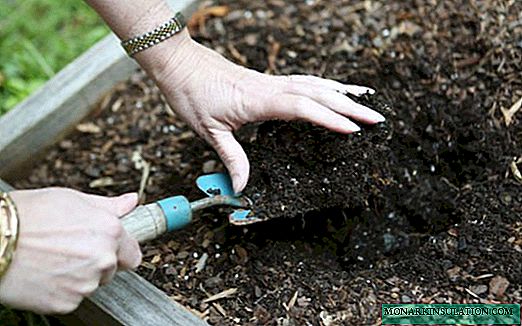
After preparing the plot, the beds are leveled with a rake and shallow holes are made
- Planting pits are shed with such quantity of water so that they are saturated to a depth of 20 cm. After watering, the wells are left for 1-1.5 hours for heating.
- The pits are lightly sprinkled with earth, made “nests” and planted several seeds to a depth of 1-2 cm, crushed with soil and slightly tamped.
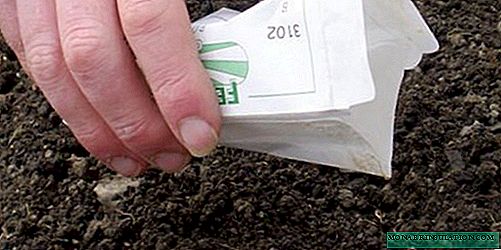
In each well, 2 seeds are placed to a depth of 2 cm, sprinkled with earth and slightly tamped
- Landings are covered with glass jars.

After sowing the seeds, the planting pits are covered with jars or plastic bottles
Planting several seeds in one hole is due to the fact that after germination one of the strongest sprouts is left, and the weaker ones are removed.
The distance between the holes directly depends on the variety of cabbage. So, early ripe varieties are planted from each other at a distance of 40 cm, and medium and late ripening varieties are 50-65 cm, since they are characterized by larger sizes. In most cases, when growing cabbage, they resort to square-nested and ordinary planting schemes. In the first case, planting is carried out at a distance of 60 * 60 or 70 * 70 cm, in the second - 90 * 50 cm. After emergence and as the plants develop, standard agrotechnical measures are carried out: watering, fertilizing, cultivating, removing weeds.

The cabbage planting pattern depends on the planted variety and ranges from 40 cm to 70 cm between plants
Video: sowing cabbage into the ground
Planting cabbage seeds in a greenhouse
Sowing crops in greenhouse conditions, as well as in open ground, begins with soil preparation and planting material.
Soil and seed preparation
Since cabbage is very fond of moisture, this feature must be taken into account when choosing and preparing the soil composition, making it fertile and easy. Earth should consist of the following components:
- 2 parts of humus;
- 1 part of turf land;
- 1 part of sand.
To prevent the development of the black leg in the soil mixture per 1 m², you need to add 1-2 tbsp. wood ash. To enrich the soil with trace elements, you will need to add potassium sulfate (20 g), ammonium nitrate (15 g), superphosphate (45 g) per 1 m². Soil of this composition will be able to provide plants with the necessary nutrition. As for the preparation of seeds, the procedure is similar to those that are carried out when sowing in open ground.

When preparing the soil in the greenhouse, organic and mineral fertilizers are added
Sowing seeds
The scheme of planting cabbage in closed ground depends on the method of cultivation. If you adhere to the basic principles of cultivation, that is, make a pick, then between the rows make a distance of 2 cm, and the seeds are planted with an interval of 1 cm. If the pick is not planned, the distance is made somewhat larger:
- between rows of 5 cm;
- between planting material 3 cm.

For sowing cabbage seeds, shallow furrows are made with a distance of 2 cm from each other
After preparing the furrows, they are shed with water, seeds are planted and covered with soil. To avoid confusion, each grade is recommended.
For faster emergence of seedlings, the bed with plantings must be covered with a film. As soon as the shoots appear, the film is removed so as not to interfere with the growth.

Planting cabbage in a greenhouse may be denser if you plan to dive plants
For the normal development of seedlings, it is necessary to ensure optimal temperature conditions. In the afternoon, the temperature should be + 15-17˚C, with cloudy weather + 13-15˚C, at night + 7-9˚FROM. At higher values, measures must be taken to bring them to normal. When shoots appear, the temperature is lowered to + 8-10 ° C in the daytime, and the readings are slightly corrected in cloudy weather. Subsequent actions for the cultivation of crops consist of standard techniques of agricultural technology with subsequent transplantation of plants into open ground.

For the normal development of cabbage in the greenhouse, it is necessary to ensure the optimum temperature
As for the timing of planting cabbage in protected ground, they depend on the region and the cultivated variety. In addition, it must be borne in mind that seedlings are planted on the site at the age of 1-2 months.
Video: how to plant cabbage in a greenhouse by seeds
Cold cabbage sowing
When cultivating cabbage at home, plants need to provide good lighting and low temperature, otherwise the sprouts will be pale and elongated. Such conditions are easy to create on the street. In this case, the seeds are planted in a seedling box, lightly sprinkled with earth and well watered. After planting, the container is taken out to the balcony, if it is an apartment, or to the garden, when grown in a private house. The place for installing the box is chosen sunny, and from above they make a shelter from the film. The appearance of sprouts should be expected in 10 days. A transplant to the site is performed as soon as 1-2 real leaflets appear.

When growing cabbage in a cold way, crops with a seedling box are placed on the balcony or in the garden under a film
Growing cabbage in a non-seedling way, it is possible to reduce labor costs, which is especially important with the advent of spring. In addition, some varieties are preferable to grow by direct sowing in the ground. Knowing how to choose and prepare the seeds and soil, as well as sowing on time, getting a good cabbage crop is not a big deal.






